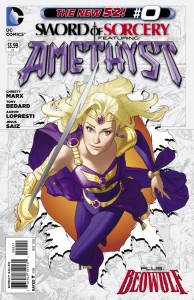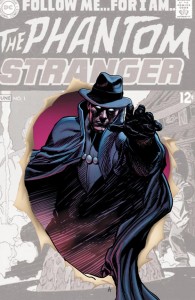 Prior to picking up Sword of Sorcery #0, I knew nothing about Amethyst, Princess of Gemworld, because when it debuted in 1983, I was a 12-year-old human being with a limited, allowance-based income, and a penis. With comics 60 cents a piece and three bucks to spend on them, I wasn’t gonna drop coin on a books meant to empower the very people giving me boners just by being around and then laughing when I got one. Besides, despite being a geek since it was a word used to describe a filthy hobo who bites the heads off chickens in a freakshow, I have never been a swords and sorcery kind of fan. I grew up on comic books, The Six Million Dollar Man and Star Wars; I had no need or time for some blonde with a sword and magical powers. Not when I had access to Luke Skywalker. Wait, something there’s not quite right…
Prior to picking up Sword of Sorcery #0, I knew nothing about Amethyst, Princess of Gemworld, because when it debuted in 1983, I was a 12-year-old human being with a limited, allowance-based income, and a penis. With comics 60 cents a piece and three bucks to spend on them, I wasn’t gonna drop coin on a books meant to empower the very people giving me boners just by being around and then laughing when I got one. Besides, despite being a geek since it was a word used to describe a filthy hobo who bites the heads off chickens in a freakshow, I have never been a swords and sorcery kind of fan. I grew up on comic books, The Six Million Dollar Man and Star Wars; I had no need or time for some blonde with a sword and magical powers. Not when I had access to Luke Skywalker. Wait, something there’s not quite right…
Anyway, what I’m getting at here is that, for me, Amethyst is a completely new character. And while I recognize that I, a 40-something guy, am not necessarily the target audience for Amethyst, I thought it was okay. It accomplished a lot in 20 pages, introducing the protagonist and doing a decent job humanizing the character and telling us her background, and explaining how what appears to be a reasonably typical teenaged girl might survive in a hostile environment like Gemworld… even including the gang bang scene. Maybe I should’ve been reading this book when I was twelve… but we’ll get to that in a minute.









 Podcast RSS Feed
Podcast RSS Feed iTunes
iTunes Google Play
Google Play Stitcher
Stitcher TuneIn Radio
TuneIn Radio Android
Android Miro Media Player
Miro Media Player Comics Podcast Network
Comics Podcast Network